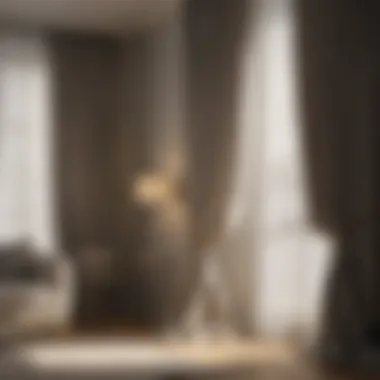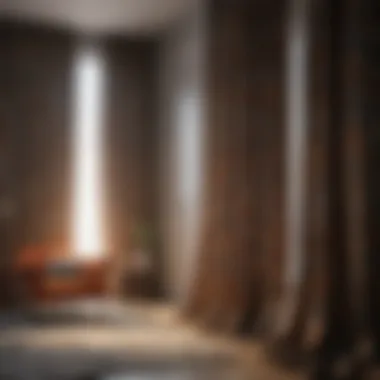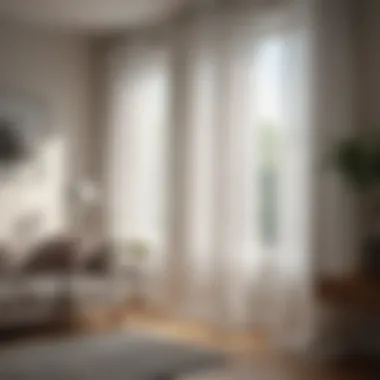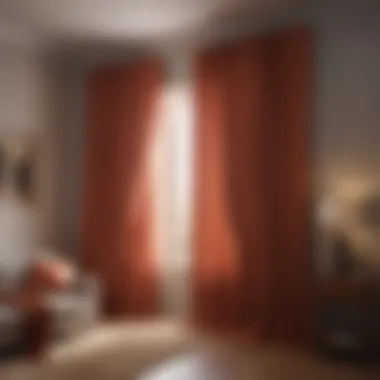Top Curtain Styles to Enhance Your Living Room


Intro
Design Inspiration
Current Interior Design Trends
Understanding the latest trends in interior design is essential when selecting curtains. Right now, minimalist designs are gaining popularity. Homes are embracing lighter fabrics in neutral shades such as beige, ivory, and soft greys. Such colors create a serene atmosphere while allowing natural light to filter in. On the other hand, bold patterns and rich colors are also making a grand comeback. Heavy drapes in velvet or silk, especially in jewel tones, can add luxury to a space.
Color Palettes and Their Effects
Colors significantly influence the mood and perception of any room. Here are some popular color choices for curtains:
- White and Cream: These colors bring a fresh and airy feel to living spaces. They pair well with any decor and make rooms feel larger.
- Muted Pastels: Soft hues like lavender or pale blue create a relaxing ambiance. They work best in spaces designed for rest or quiet activities.
- Bold Jewel Tones: Colors like emerald green, sapphire blue, or deep burgundy can introduce drama and luxury to the living room.
"Choosing the right color for your curtains can change the whole atmosphere of your living space."
A practical aspect to consider is how well the curtain colors coordinate with existing furniture and decor. Textures, such as linen or silk, can also alter perception—matte fabrics tend to give a more relaxing vibe, while glossy materials often feel more formal.
Energy Efficiency and Practicality
In addition to aesthetics, curtains can significantly impact energy efficiency. Thermal curtains are designed to retain heat in winter and block it during summer, which can lead to considerable energy savings. Homeowners should consider the installation of blackout curtains as well. These are especially useful for bedrooms but can also minimize glare in living spaces, making them suitable for media rooms.
When choosing curtains, maintenance is also important. Fabrics that are machine washable or can be easily wiped clean are preferable for high-traffic areas. Lightweight materials often allow for easy laundering, while heavier fabrics may require professional cleaning.
Culmination
Ultimately, curtains are not just a decorative element; they are integral to the overall design and functionality of your living space. Understanding the current trends, colors, textures, and practical features will empower you to make informed decisions. With careful selection, you can turn your living room into a stylish haven that reflects your personality and meets your needs.
Understanding Curtain Functionality
Curtains in a living room serve more than just an aesthetic purpose. They influence the overall ambiance and functionality of the space. Understanding their functionality is crucial for anyone considering new curtains. By focusing on specific elements like privacy, light control, and energy efficiency, one can make informed decisions that impact both the comfort and style of a living area.
Purpose of Curtains in Living Rooms
Curtains play a vital role in defining the character of a living room. They create a sense of warmth and can act as a focal point within the space. Aside from aesthetics, curtains offer practical benefits. For instance, they help in creating boundaries within the area—allowing for separation from the outside world. Homeowners often choose curtains that resonate with their personal style, while also enhancing the visual narrative of the room.
Light Control and Privacy
One of the essential functions of curtains is to regulate light and offer privacy. Depending on the material and thickness, curtains can either filter light or block it entirely. This ability to control sunlight can significantly influence the mood of the room. For example, sheer curtains allow natural light to seep through, creating an airy feel, while thicker drapes provide privacy and darkness. The choice of curtain type can directly affect how a living room is perceived.
Energy Efficiency Aspects
Energy efficiency is becoming increasingly important in home design. Curtains can contribute to maintaining a comfortable temperature within a living room. During colder months, heavy drapes can act as insulators against drafts, keeping warmth in. In warmer months, reflective materials can help to keep interior spaces cooler by blocking out heat. By selecting the right curtains, homeowners can not only enhance their living environment but also reduce energy consumption.
"Curtains are vital in creating a balance between comfort, style, and efficiency in living spaces."
In summary, understanding the functionality of curtains is fundamental when making decorating choices. Whether it's about achieving privacy, controlling light, or improving energy efficiency, these aspects contribute significantly to the overall livability and aesthetics of a home.
Exploring Curtain Styles


Exploring curtain styles is essential when enhancing the aesthetics of a living room. The right style can elevate the overall ambiance, defining a space's character and mood. Selecting curtains involves considering various elements such as the theme of the room, the intended use of the space, and the practicality of each style. This section highlights the different curtain styles available and explains their significance in home design.
Traditional Draperies
Traditional draperies represent timeless elegance. They often feature rich fabrics, intricate patterns, and elaborate details. These curtains typically extend from ceiling to floor, contributing to a grand appearance. Common materials for traditional draperies include silk, velvet, and heavy cotton which add a sense of luxury.
Key benefits include their ability to control light effectively and enhance privacy. They work well in formal living rooms and often coordinate with other furnishings. Homeowners appreciate their classic style, which can remain relevant amid changing trends.
Modern Curtains
Modern curtains often emphasize minimalism and streamlined designs. They are usually made from simpler fabrics, like polyester blends, which offer practicality and ease of maintenance. Unembellished patterns, solid colors, and geometric shapes are common in modern curtain designs.
The benefit of choosing modern curtains lies in their versatility. They can adapt to various interior styles while providing a clean and sophisticated look. Additionally, they are often lighter, which allows for easier handling and installation compared to heavier traditional options.
Sheer Curtains
Sheer curtains serve a unique purpose in home décor. Their lightweight fabric allows sunlight to filter in while still providing a degree of privacy. Sheer curtains create an airy and open feel in a living room while softening harsh edges from furniture and architecture.
They work particularly well in combination with heavier curtains, allowing homeowners to enjoy versatile light control. Sheer curtains can also enhance the color and texture of a room without overpowering other design elements.
Blackout Curtains
Blackout curtains are designed to block outside light, making them a practical choice for bedrooms or media rooms. They can also be beneficial in living rooms where reducing glare on screens is needed. The fabric used in blackout curtains is typically thicker and heavier than traditional curtains.
A significant advantage of blackout curtains is their energy efficiency. They help regulate indoor temperatures and can contribute to reduced energy costs. These curtains come in various styles, allowing for aesthetic appeal without compromising functionality.
Valances and Cornices
Valances and cornices add a decorative finish to windows. They can stand alone or complement other curtain styles. Valances are typically shorter, covering only the top part of windows, while cornices are made from a rigid structure that creates a defined edge at the top.
Choosing valances or cornices provides an opportunity to introduce new colors and patterns into the living room. They help to soften the starkness of window frames and can be used creatively in combination with other curtain styles. Homeowners appreciate their decorative potential, making them a popular choice in various interior designs.
Material Considerations in Curtain Selection
When selecting curtains for your living room, the material plays a crucial role in determining both functionality and aesthetics. Each fabric type brings its own unique characteristics, affecting aspects like appearance, durability, light filtering, and ease of maintenance. Understanding these materials helps homeowners make an informed choice that aligns with their priorities, whether it's style, practicality, or a balance of both.
Cotton and Linen
Cotton and linen are popular choices for living room curtains. Both materials are known for their breathability and versatility.
- Cotton offers a soft feel and is easy to clean, making it suitable for households with pets or children. It's resistant to fading and holds its shape well over time. The variety of colors and patterns available in cotton also enhances its appeal, allowing customization to fit diverse interior designs.
- Linen, on the other hand, brings a more textured and organic appearance. It has a natural charm that can elevate a space. Linen tends to wrinkle easily, which can be an aesthetic choice for some. However, it requires a bit more care since it may lose color when washed frequently. This material is perfect for creating a relaxed and airy atmosphere, especially in light colors.
Polyester and Blends
Polyester is favored for its durability and low maintenance. It is resistant to shrinking, stretching, and wrinkling, making it a practical choice for daily use. Additionally, polyester blends often combine the best features of various materials, such as the softness of cotton with the durability of synthetic fibers.
- Benefits of Polyester:
- Easy cleaning, often machine washable.
- Variety of textures and styles available.
- Good light control options, from sheer to blackout finishes.


These characteristics make polyester suitable for various decorative styles, from modern to traditional. For households that prefer a straightforward approach to maintenance, polyester curtains are a wise selection.
Silk and Synthetic Fabrics
Silk, known for its luxurious finish, can transform any living room into a space with elegance. However, while silk curtains add a rich texture and a sense of opulence, they do come with certain drawbacks.
- Silk tends to fade in direct sunlight, and cleaning requires special care. This makes silk a more suitable option for decorative purposes rather than heavy use. The cost can also be a factor, as high-quality silk often comes at a higher price.
In contrast, synthetic fabrics offer an affordable alternative without sacrificing style. These materials can mimic the look of silk and offer diverse patterns and colors. They generally resist fading and are easier to care for than natural silk. This versatility means they are increasingly popular among homeowners looking for chic yet practical solutions.
In summary, the choice of curtain material significantly impacts the overall look and functionality of your living room. Consider lifestyle factors such as maintenance, light control, and style to find the perfect balance. Whether you opt for the softness of cotton, the durability of polyester, or the elegance of silk, informed selection ensures that your curtains enhance your living space.
Color and Pattern Impact
Color and pattern in curtains play a critical role in shaping the overall aesthetic of a living room. The choices made in this regard can enhance or diminish the ambience. A well-chosen color scheme can harmonize elements within the room, while carefully selected patterns can add depth and visual interest. Understanding these impacts is essential for homeowners and those interested in interior design, as it directly influences the feel and function of their living spaces.
Choosing Color Schemes
Selecting a color scheme for curtains involves several considerations. It is not merely about personal preference; it includes how colors interact with existing decor and the emotions they evoke. Here are some tips:
- Neutral Colors: These tend to blend well with various styles. Beige, gray, and white are popular, providing a calm backdrop that allows other elements to shine.
- Bold Colors: Using deep blues or rich reds can create a statement. However, balance is essential. Pairing bold curtains with subtler furnishings can prevent overwhelming the space.
- Accent Colors: Choosing curtains that complement other colors in the room can create a cohesive look. For example, if cushions or artwork display a splash of yellow, opt for curtains that incorporate this hue.
Color impacts natural light and perception of space. Light colors can make a room feel larger and more open, while darker colors can create warmth and coziness. Knowing these dynamics makes it easier to select the appropriate shades.
The Role of Patterns
Patterns can significantly enhance the character of your living room. They can inject vibrancy or set a tone of elegance, depending on the design. Patterns should be chosen thoughtfully to ensure they resonate with the overall style of the home. Here’s what to bear in mind:
- Types of Patterns: Stripes, florals, geometric shapes can each tell a different story. For instance, stripes can give a feeling of height, while floral designs can evoke a sense of nature.
- Pattern Scale: Large patterns may dominate a room, while small ones can serve as a subtle enhancement. It’s crucial to consider how the scale of pattern interacts with other design elements.
- Mixing Patterns: This practice can successfully add texture and visual intrigue. However, they should share a common color to create harmony.
Patterns can act as focal points in a room. They draw the eye and can effectively guide the viewer's experience of the space. Choosing the right patterns ensures both flair and functionality.
"The right color and pattern can completely transform a living space. Understanding their impact is fundamental for effective interior design."
Ultimately, these decisions—colors and patterns—are not mere aesthetic choices. They influence emotion and perception, thus playing a vital role in the creation of a desirable and inviting living room environment. Every homeowner should invest time in selecting curtains that reflect their personality while also aligning with their living spaces' broader design narrative.
Popular Curtain Trends
The choice of curtains significantly influences the atmosphere and aesthetic of a living room. The current trends in curtain designs reflect broader styles in interior decoration, and understanding these trends offers a pathway to elevate living spaces. Popular curtain trends highlight the merging of practicality and artistry, catering to diverse tastes and functional needs.
In this section, we will delve into the eclectic styles and minimalism and simplicity, both of which have gained traction in recent years. Adopting these trends in curtains not only enhances the visual appeal of a room but also addresses factors such as ease of maintenance and integration with modern lifestyles.
Eclectic Styles
Eclectic styles in curtains embrace a mix of colors, patterns, and textures, catering to those who appreciate individuality in home decor. This trend offers flexibility, allowing homeowners to creatively express their personality through their choice of curtains. An eclectic approach can incorporate various elements, such as bold prints combined with softer textures or unique fabric blends that tell a story.
For example, combining geometric patterns with floral designs can create a vibrant contrast. When selecting eclectic curtains, consider the following:
- Contrast: Utilize contrasting colors and patterns to make a statement.
- Layering: Experiment with layering textures. Consider adding sheer curtains behind heavier drapes to provide depth and dimension.
- Mix and Match: Don’t be afraid to combine different styles. Vintage and contemporary can coexist beautifully when done thoughtfully.


"Eclectic styles allow a personalized expression that can truly transform a room into a reflection of your taste."
The benefits of this trend include the ability to customize your living room space, giving it a unique flair. However, blending different styles requires careful consideration to maintain harmony.
Minimalism and Simplicity
On the other hand, minimalism and simplicity focus on clean lines and understated elegance. This trend aligns with contemporary with busy lifestyles, where simplicity can lead to a serene environment. The less is more approach emphasizes functionality without sacrificing beauty.
When selecting minimalist curtains, considerations should include:
- Neutral Colors: Choosing curtains in shades of gray, beige, or white promotes a calm ambiance.
- Sleek Fabrics: Opt for materials like linen or light cotton that drape elegantly without excess bulk.
- Simple Hardware: Use streamlined curtain rods that blend seamlessly with the fabric.
This approach benefits homeowners looking to create a tranquil living room space. It also allows for easy maintenance, as simpler curtains tend to collect less dust and require less frequent cleaning.
The End
Understanding these trends in curtains can guide a homeowner in making informed decisions. Whether your choice is the vibrant eclectic or the serene minimalist, both styles offer unique advantages that can significantly enhance your living area. By carefully considering the trends that resonate with your personal style, you can create a harmonious living environment that reflects who you are.
Practical Considerations
When selecting curtains for a living room, practical considerations play a crucial role. They go beyond mere aesthetics, impacting not only the overall look but also the functionality of the space. Key elements include maintenance, length and dimensions, and installation techniques. Understanding these factors can lead to better decision-making and a more satisfying choice.
Maintenance and Care
Routine care of curtains is vital to prolong their life and maintain their appearance. Depending on the fabric, some curtains may require specific cleaning methods. For example, cotton curtains can usually withstand machine washing, while delicate silk curtains might need dry cleaning. Furthermore, dust can accumulate, making regular vacuuming beneficial. This will keep the fabric looking fresh and prevent fading caused by sunlight exposure. Establishing a cleaning schedule ensures your curtains remain in optimal condition and enhances the living room's overall aesthetic.
Curtain Length and Dimensions
Selecting the right length and dimensions can drastically alter the perception of space in a living room. Curtains that are too short may look out of place, while excessively long ones can appear unkempt. Standard options include floor-length curtains or those just above the window sill. It is also important to consider the width. Generally, curtains should be 1.5 to 2 times the width of the window for a fuller look. These dimensions help create an illusion of height and sophistication while allowing natural light to flow when open.
Installation Techniques
Proper installation is essential for achieving desired curtain effects. This involves choosing the right hardware and adhering to installation guidelines. For heavier fabrics like drapes, sturdy brackets and rods are necessary. Incorrect installation can lead to sagging or misalignment, affecting both looks and functionality. It is advisable to measure accurately, ensuring curtains hang as intended. Engaging a professional can also simplify this process, guaranteeing that your curtains add beauty and utility to your living space.
"Thoughtful practical considerations transform mere fabric into a critical element of a well-designed living room."
By keeping these practical aspects in mind, homeowners can ensure their curtain choices are not only stylish but also functional, enhancing the living room experience.
Budgetary Considerations
Understanding the budgetary aspect of curtain selection is crucial for homeowners and interior design enthusiasts alike. It not only affects the choices in style and material but also dictates the overall aesthetic and functionality of the living room. Proper budget management ensures that one can find stylish curtains without compromising quality. When selecting curtains, it is wise to balance cost with the desired value and longevity of the product. Curtains are an investment; they play a significant role in creating a desired atmosphere and lifestyle in your home.
Balancing Quality and Cost
When considering curtains, you should prioritize finding the right balance between quality and cost. High-quality curtains may have a higher initial pricing but tend to last longer and maintain their appearance. The materials used can significantly influence this balance; natural fabrics like cotton or linen may come at a premium compared to synthetics like polyester. Think about durability, as well as the frequency of use in your living space. Higher-quality curtains often require less frequent replacement, which can be more economical in the long run.
- Key points in balancing quality and cost:
- Material Selection: Opt for materials that offer durability.
- Craftsmanship: Well-made curtains provide better value over time.
- Functionality Needs: Identify if you need heavier fabrics for light control or sheer options for more light.
Where to Buy Curtains
Finding good quality curtains involves knowing where to shop. There are various options available, from local boutiques to online retailers. Each has its advantages and potential drawbacks. Shopping in physical stores allows you to feel the fabric and see the colors in person, which can be a significant advantage. On the other hand, online platforms provide more variety and often better prices.
- Recommended Places to Buy:
- HomeGoods – Known for a wide selection at reasonable prices.
- Wayfair – An online resource with a broad range of styles.
- IKEA – Offers simple, affordable options that can fit various aesthetics.
- Local Custom Drapery Shops – Ideal for tailored solutions but can be costlier.















